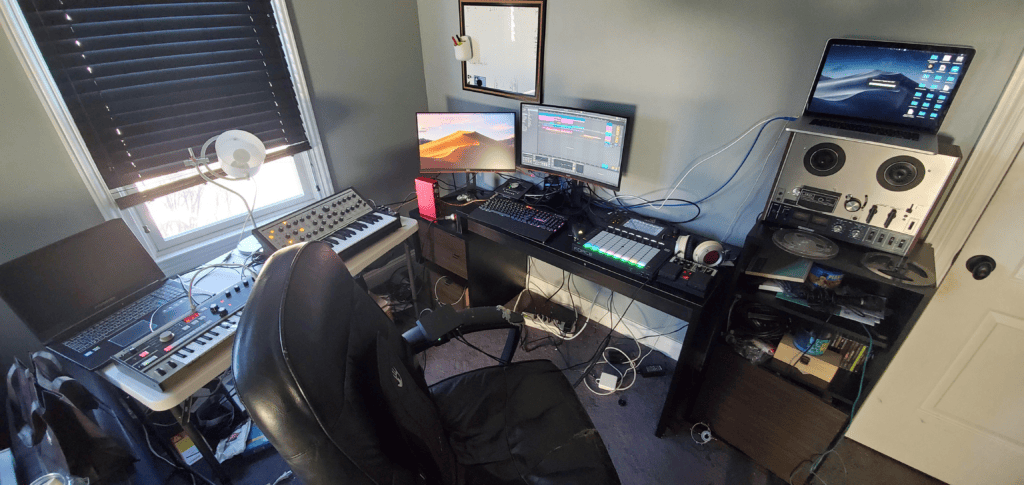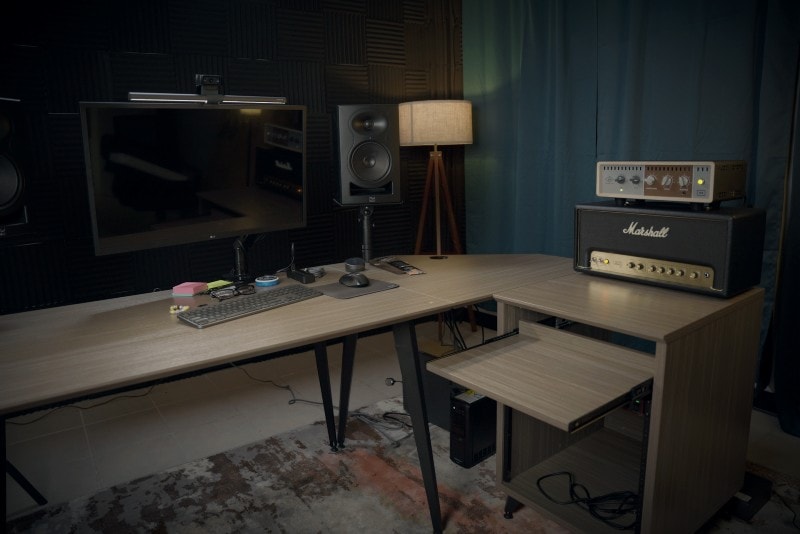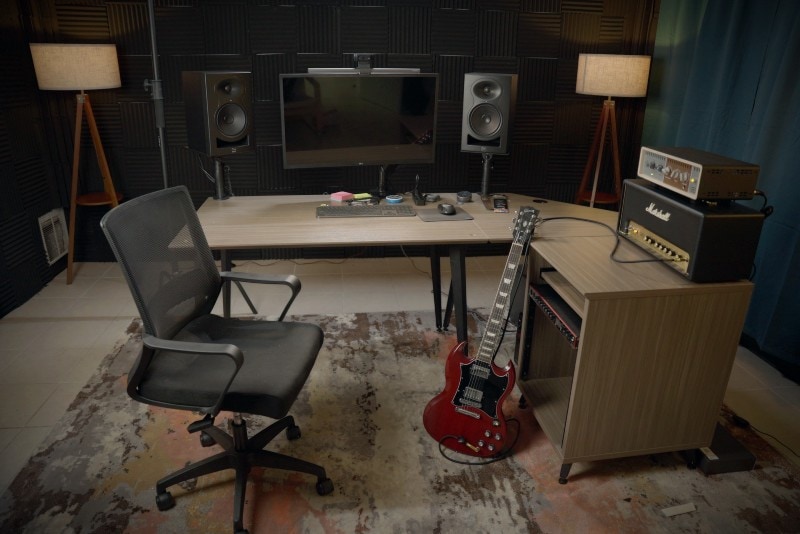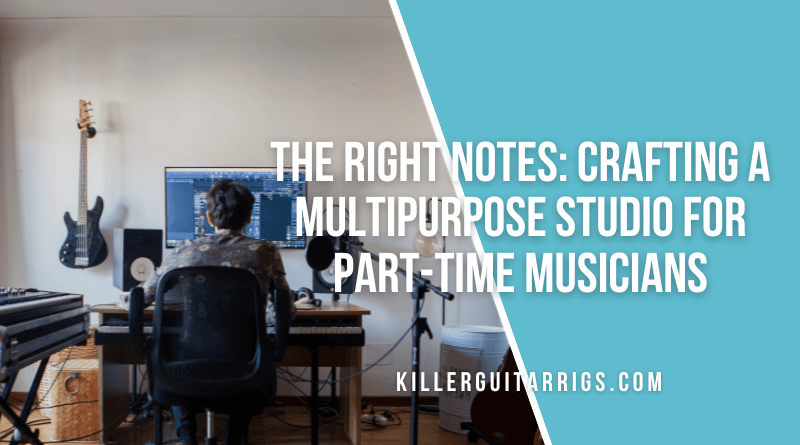If you’re a full time music producer, recording engineer, or anyone else who sits at their desk all day making music, you’re in a well catered to demographic, with tons of desks for you to choose from, ranging from a couple of hundred dollars all the way up into the tens of thousands.
But what if making music is just a hobby? Sure you would like somewhere to put some rack gear, maybe a Kemper and an amp head or two, but do you also need a desk where you can do office work, study, or any other activity where you need a lot of available desk space?
In this KillerGuitarRigs Guide, we’re going to show you how to weigh what’s most important for you based on your needs and your budget, then we’re going to walk you through your options for setting up a mixed use desk. We’re also going to show you what we settled on for our new studio office – a desk system that allows us room for rack gear, amps, as well as loads of desk space for working with books, and even space to film.
Let’s get stuck in!
Contents
Understanding Your Needs

Before you start looking at desks, it’s important to first know what exactly you need out of your hybrid desk setup. There’s no point looking for rack space if you don’t have rack gear and don’t plan to buy any, and there’s no point in looking at desktop rack units if you need a ton of space for studying with textbooks.
Make a list of your needs for both your audio work and your non-audio use of the desk, as well as what you might like to do once you have the ideal setup. Maybe you want to invest in more rack gear once you have the chance, or maybe you want more desktop space to put a bunch of amps. Plan ahead and plan well.
Next you’ll want to think about your budget – but not just for the desk. If the new desk means you’ll be buying extra rack gear, amps, keyboards, or any other audio gear, factor for that too. You don’t want to blow your budget on a desk before realizing you now can’t afford to expand.
Exploring Your Options
There are a lot of different options for combining a regular desk and some studio add ons – enough to make it a difficult choice! In this section we’ll assume your main desk will be a traditional work desk setup – something like your typical Ikea Bekant desk that everyone owns at some point.
Desk Racks

If you have a very small amount of rack gear, and don’t need a lot of desktop space, a desk rack can be a great option. Desk racks are like small shelving units that sit on top of your desk, typically under your monitor, and give you a few slots of rack space to have your gear to hand. These can be especially useful for those with small rooms where having more furniture like a sidecar isn’t practical.
With all that said, the big drawback of a desk rack is that it will eat up a lot of space on top of your desk, likely leaving you with only enough space for your mouse and keyboard. In addition, you will be quite limited when it comes to expanding the amount of rack gear you have – once your spaces are full, there’s nowhere to go unless you want to crane your neck up looking at your monitor!
Sidecar Rack

A sidecar is a piece of furniture that sits alongside your main desk and provides extra rack space, typically at a level below the surface of your main desk. Some sidecars also allow you to have things like slide out trays for keyboards, headphones, or other essential gear.
Sidecars range in price from somewhere around $400 and up, and can be a great way to keep that extra rack gear, or a rack interface, or a unit like a Kemper to hand without cluttering up the main desk. However, they’re typically too heavy to move around, so will most likely be a permanent fixture in your room. You will likely also struggle to get one that matches both the height and aesthetic of your existing desk.
Rolling Rack Stands

Rolling rack stands are quite similar to sidecars in that they’re essentially rack unit storage that sits alongside your desk, but they come on wheels – making it much easier to move your rack gear around as needed. This can be quite helpful in a small room setting where you might want to hide away your rack gear during the week and bring it back out at the weekend.
However, as with the sidecar it can be hard to match these with your existing desk – especially as most rolling rack stands are metal racks similar to a guitar stand, specifically to keep the weight down to facilitate moving around the room.
Our Pick: The Modular System

When we were researching our options for the new KillerGuitarRigs studio, we considered all of the above and after seeing one specific unit on both Ryan Bruce and Rhet Shull’s channels, we decided to go with a desk that combines all of the above, while allowing us to mix and match – specifically, a modular system, the Gator Frameworks Elite Series Complete Desk Package (review here).
Shout out to our friends at Sweetwater who agreed to send us the desk for the studio – though they didn’t ask us for specific content around the desk, so everything in this article is as ever our own opinion on the desk.

This system comes with a main desk with a very large desktop area (good for laying out books, magazines, taking notes, arranging pedals, and anything else we need to do), a 10u sidecar with a rolling shelf for storing headphones and other occasional use items, and a corner unit to attach both together, giving us even more desktop space to keep several amp heads, our UA Ox Box, and a handful of pedals as we test them out in our chain.
In addition, the desk comes with an optional desk rack setup that allows you to choose between a 4U configuration or an 8U configuration (leaving the remaining space for storage), and an optional pullout keyboard/synth tray big enough to accommodate a 49 note keyboard.
We didn’t want to use the additional desk rack space (we want more open space on the desk) or the keyboard tray (we don’t use keyboards at this time), so the beauty of a modular desk came into effect – we just skipped out on installing them! This saved us a ton of time in the setup, and it meant we got exactly the desk we wanted, with all parts at the same height in the same finish.

Final Thoughts On A Multipurpose Studio
Most of us who dabble in recording dream of a life where it can be our full time passion, that is until reality comes crashing down and you realize that a 204 track console with half a million dollars worth of rack gear doesn’t leave you space to prepare your TPS reports.
In the meantime, coming up with a multipurpose solution to balance your work, study and play time can be tricky, but as long as you’re clear about what you actually want out of the space and plan accordingly it can be done. The Gator desk we use in our studio is a massive step up from the cobbled together Ikea and sidecar solution we had previously – so, if you’re anything like us, it might be great for you too.


